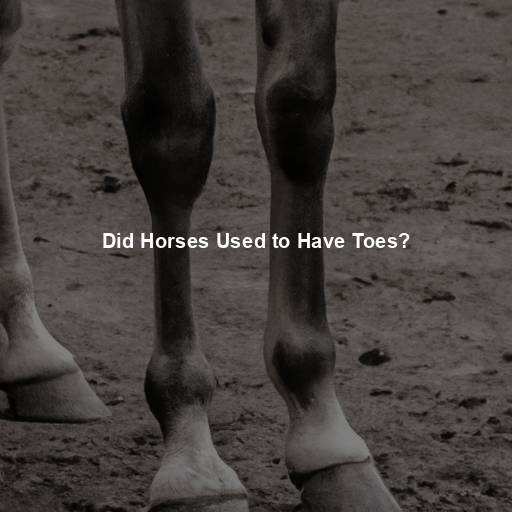Did Horses Used to Have Toes?
Last Updated on November 21, 2023 by Evan
Contents
- 1 Exploring the Evolutionary History of Horses
- 1.1 The Ancestry of Horses
- 1.2 From Toes to Hooves
- 1.3 The Impact of Natural Selection
- 1.4 The Evolution of the Hoof
- 1.5 The Role of Fossil Records
- 1.6 The Hyracotherium Connection
- 1.7 The Impact of Climate Change
- 1.8 Modern Horses and Their Hooves
- 1.9 Tracing the Remnants
- 1.10 Functional Significance
- 1.11 The Evolutionary Advantage
- 1.12 Parallel Evolution in Other Species
- 2 The Significance of Toes in Equine Evolution
- 3 The Fascinating Journey of Horse Evolution
- 4 Exploring the Past, Appreciating the Present
- 5 FAQs – Did Horses Used to Have Toes?
Exploring the Evolutionary History of Horses
Horses are majestic creatures that have captivated humans for centuries. With their sleek bodies, flowing manes, and powerful strides, they have become symbols of freedom, strength, and grace. But have you ever wondered about the fascinating evolutionary journey that has shaped these magnificent animals? Did horses used to have toes?
The Ancestry of Horses
To understand whether horses used to have toes, we must first delve into their ancient ancestry. The evolutionary history of horses dates back millions of years, with their earliest known ancestors appearing around 55 million years ago. These early equids, known as eohippus or “dawn horses,” were small, dog-sized animals that inhabited forests and lived off a diet of leaves and fruit.
From Toes to Hooves
In their early evolutionary stages, horses did indeed possess toes. Eohippus had four functional toes on their front feet and three on their hind feet. These toes were equipped with small hooves, allowing them to navigate through the dense forests they called home. However, as time passed and their environment changed, horses underwent remarkable adaptations that would shape their future.
The Impact of Natural Selection
The awe-inspiring journey of horses as they ventured into the vast expanse of open grasslands ignited a captivating interplay between nature and adaptation. As if touched by the hand of destiny, those horses graced with elongated legs and remarkably diminished toes claimed a mighty advantage, outpacing their relentless predators and foraging with remarkable ease. With each passing epoch, the whims of natural selection meticulously favored these exceptional equines, gradually shedding the burden of excess digits and unveiling a captivating transformation in the horse kingdom.
The Evolution of the Hoof
The reduction of toes in horses eventually gave rise to the single-toed hooves we are familiar with today. This transition occurred through a series of evolutionary stages. The first notable change was the elongation of the central toe, known as the middle digit. This elongation provided increased support and stability while running.
The Role of Fossil Records
Throughout the annals of time, the enigmatic realm of fossil records has embarked on a mesmerizing journey, unveiling the intricate tapestry of the horse’s ancient lineage. Like a miraculous time capsule, paleontologists have meticulously unearthed a treasure trove of fossils, illuminating the cryptic nuances of equine evolution. With reverent awe, they behold the myriad fossils, each whispering tales of untold transformations, as the once multi-toed eohippus metamorphosed into the majestic singular-toed marvel we know today. These priceless relics serve as an enigmatic key, unlocking the enigma of horse ancestry.
The Hyracotherium Connection
Delve into the enigmatic past and discover the awe-inspiring tale of the enigmatic Hyracotherium. With its three toes per foot and a middle toe that outshone the rest, this prehistoric equid captivates minds, perplexing us with its mysterious existence. Lounging in the ancient realm some 50 million years ago, Hyracotherium foreshadowed the hoofed wonders we admire today, leaving behind tantalizing fossils that unlock the secrets of horse evolution. Embark on a journey through time, where the burstiness of Hyracotherium’s lineage unfolds, painting a vivid portrait of the equine family tree.
The Impact of Climate Change
Throughout the course of history, the humble horse has experienced quite the transformative journey. It is captivating to ponder the intricate relationship between climate change and their extraordinary evolution. As the lush forests surrendered to expansive grasslands, these majestic creatures found themselves facing a perplexing conundrum – how to thrive in their altered habitat. Nature, as always, found a way, favoring those equines with elongated legs that propelled them to newfound levels of speed and agility.
Modern Horses and Their Hooves
Today, horses possess a single toe on each foot, encased in a tough, keratinous structure known as a hoof. The hoof is a remarkable adaptation that allows horses to bear their weight and move with agility and grace. It acts as a shock absorber, protecting the underlying bones and providing traction on various terrains. The modern horse’s hoof is a testament to the evolutionary journey that has shaped these magnificent animals.
Tracing the Remnants
While horses no longer possess functional toes, vestigial remnants of their ancient toe structure can still be found in their anatomy. These remnants serve as reminders of their evolutionary history. Deep within the equine leg, hidden beneath layers of muscle and tendons, lie small bones known as splint bones. These bones are the remnants of the second and fourth toes that once existed in horses’ ancestors.
Functional Significance
Although the splint bones in modern horses are non-functional, they can sometimes cause issues. In some instances, the splint bones may become inflamed or develop bony growths, leading to discomfort or lameness. This condition, known as splints, is more common in young horses during their growth and development phase. Vets and farriers carefully monitor and manage splints to ensure the well-being and soundness of the horse.
The Evolutionary Advantage
The reduction of toes and the development of the hoof provided horses with several advantages that allowed them to thrive in their changing environment. The single-toed hoof allowed for increased speed and agility, enabling horses to outrun predators and navigate various terrains with ease. The hoof’s structure also distributed the weight of the horse evenly, reducing the risk of injury and providing stability during rapid movements. These adaptations played a crucial role in the survival and success of horses throughout their evolutionary journey.
Parallel Evolution in Other Species
While the reduction of toes and the development of hooves is a defining characteristic of horses, it is important to note that other animal species have undergone similar evolutionary changes. The evolution of hooves has occurred independently in various lineages, such as rhinoceroses and tapirs. These animals, like horses, have transitioned from multi-toed ancestors to single-toed forms with specialized hooves. This parallel evolution highlights the adaptive advantages offered by the hoof structure in multiple lineages.
The Significance of Toes in Equine Evolution
The Role of Toes in Eohippus
Throughout history, toes have truly been unsung heroes for the ancient equids, like the remarkable eohippus. In the dense forests they once called home, these creatures relied on their ingenious multiple toes to gracefully maneuver through the tangled wilderness, exhibiting a remarkable blend of nimbleness and adaptability. By skillfully distributing their weight, these practical toes ensured minimal strain on their joints, effectively shielding them from potential harm. The evolution of functional toes in eohippus was nothing short of a masterstroke, tailored perfectly to suit their unique surroundings and way of life.
Changing Environments and Selective Pressures
As horses gradually moved from forests to open grasslands, their environment underwent significant changes. These changes exerted selective pressures on the equine lineage, favoring individuals with adaptations that improved their chances of survival in the new grassland habitats. The reduction of toes and the development of longer limbs became advantageous traits, enabling horses to outrun predators and access food sources more efficiently. Natural selection played a pivotal role in driving the evolutionary changes that led to the loss of functional toes in horses.
The Impact of Diet and Foraging Behavior
As the world around them transformed, horses had to navigate the enigmatic journey from lush forests to sprawling grasslands. This paradigm shift wreaked havoc on their ancient dietary habits, prompting a perplexing battle for survival. Once devout leaf and fruit aficionados in the dense greenery, they were forced to embrace the uncharted world of grass grazing when the grasslands reigned supreme. A seemingly impossible task, their bodies contorted and their toes vanished, paving the way for a more efficient and adaptive existence in this perplexing new landscape.
Adaptation to Running
Picture this – the open grasslands stretching far and wide, creating an expansive playground for horses to unleash their untamed spirit. But what really sets these majestic creatures apart? It’s the seemingly insignificant reduction of toes that paved the way for their remarkable speed. With an elongated middle toe and the emergence of the iconic hoof, horses gained a specialized tool for swift locomotion.
The Fascinating Journey of Horse Evolution
The Story Told by Fossils
Over the ages, fossils have played an indispensible role in untangling the intricate web of horse evolution, leaving us in awe of these ancient creatures. With painstaking precision, paleontologists delve deep into the remains of the past, determined to decipher its enigmatic code. It is through the invaluable insights of fossil records that we are able to catch glimpses of the ever-changing nature of horses, as their anatomy and behavior evolved over the course of countless years. Notably, the fossilized horse series, featuring remarkable species like Mesohippus, Merychippus, and Pliohippus, has gifted us with a vivid tapestry illustrating the sweeping journey these majestic animals embarked upon.
The Influence of Genetics
While fossil records provide a tangible glimpse into the past, modern scientific techniques have allowed researchers to delve even deeper into the mysteries of horse evolution. Genetic studies have provided additional evidence to support the evolutionary relationships between different horse species. By analyzing the DNA of modern horses and comparing it to that of their ancestors, scientists have gained a more comprehensive understanding of the genetic changes that have shaped these magnificent creatures.
Human Influence on Horse Evolution
Throughout history, humans have played a significant role in shaping horse evolution. The domestication of horses, which began around 6,000 years ago, has led to the development of numerous breeds with distinct characteristics. Selective breeding practices have further refined these traits, resulting in the incredible diversity of horse breeds we see today. From sturdy draft horses to elegant thoroughbreds, humans have harnessed the potential of horse evolution to suit various purposes, from agriculture to transportation to sport.
The Enduring Bond Between Humans and Horses
The timeless rapport between humans and horses is nothing short of awe-inspiring. From ancient times to the present day, horses have transcended their evolutionary path to become unequivocal partners in our endeavors. Whether galloping through history as our steadfast companions in transportation and warfare or gracefully contributing to agriculture and therapy, horses have woven themselves into the very fabric of our existence. Their undeniable allure, both in terms of their physical prowess and nurturing qualities, remains an enigma that continuously sparks wonder and fascination.
Exploring the Past, Appreciating the Present
As we uncover the mysteries of horse evolution and reflect on their rich history, we gain a deeper appreciation for these magnificent animals. From their multi-toed ancestors navigating dense forests to the single-toed, hoofed creatures that grace our pastures today, horses have undergone a remarkable journey of adaptation and transformation. Their story serves as a reminder of the incredible diversity of life on Earth and the intricate web of connections that shape our world. So, the next time you gaze into the soulful eyes of a horse, take a moment to appreciate the legacy of their evolutionary past and the enduring bond between humans and these majestic creatures.
FAQs – Did Horses Used to Have Toes?
Did horses have toes in the past?
In the fascinating world of ancient equine history, it may come as quite a surprise that our hoofed companions of the past sported a rather peculiar feature – toes! Unveiling the mysteries of the ungulate kingdom, these remarkable creatures, akin to horses, rhinoceroses, and even tapirs, possessed a petite stature comparable to that of a humble canine. Straying from the conventional singular hoof we recognize today, these delightful equines boasted multiple toes on their dainty feet, usually flaunting an impressive collection of four or five digits. An evolutionary marvel indeed, this surplus of toes granted them a unique advantage, enabling a firm grip on the earth beneath them as they gracefully traversed the terrain.
How did horses lose their toes?
Over millions of years, the evolution of horses went through various stages. The number of toes gradually reduced as they adapted to different environments and changes in their way of life. The development of a single toe, known as the “hoof,” was an advantageous adaptation for horses that occupied open grasslands. The single solid hoof provided better speed, endurance, and stability, enabling them to outrun predators. This process of reduction and eventual loss of extra toes is known as “hoof reduction” or “digit reduction.”
When did horses lose their toes?
Throughout millions of years of evolution, horses underwent a bewildering transformation from their multi-toed predecessors to the elegant single-toed creatures we know today. The fossil record provides a perplexing glimpse into this awe-inspiring journey, indicating that the gradual loss of toes spanned an astonishing timespan, from approximately 50 million years ago to a mere 5 million years ago. This captivating process unfolded not as a sudden metamorphosis, but as a series of mesmerizing intermediate stages, leaving us in awe of the countless twists and turns that facilitated the horse’s remarkable evolution.
Why did horses lose their toes?
Throughout the evolution of horses, a fascinating transformation occurred in their toe count, triggering curiosity about the underlying forces at play. Unraveling a tale of adaptation, diverse terrains exerted distinct pressures on their foot structure, paving the way for a fateful transition. Witnessing the triumph of a single hoof design, horses gained unparalleled swiftness, stamina, and nimbleness that gave rise to a cutting-edge survival strategy. As generations unfolded, the fittest equines, devoid of extra digits, soared as frontrunners in these dynamic landscapes, ultimately bidding farewell to their superfluous toes.
Do any animals still have more than one toe?
It’s astonishing how the natural world never ceases to surprise us, even in the realm of digits and toes. Take tapirs, for instance, ancient kin of horses, who defy convention with their four toed front feet and three toed hind feet. And let’s not forget the mighty rhinoceros, sporting three sturdy toes on each foot. These creatures, occupying a distinctive branch of evolution, have thrived through their own remarkable adaptations that render multiple toes advantageous for their individual lifestyles. Who would have thought that the world of toes could be so captivating and perplexing?







